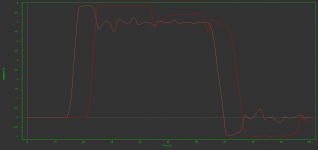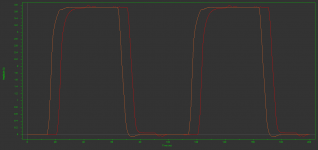reflections are fixed by using 75Ohm connectors and 75Ohm cable. simples. Now if you use something that is not impedance matched (say Kimber Silver Kludge) you only have yourself to blame.
Noted, and no offence taken.I was just sharing something I observed/hear. In fact SPDIF receiver PSU test taken few years ago was blind test (by another diyaudio member) at first he was skeptical, but as he switched PSU from switching to linear back and forth while I listened, my preferred choice was clearly identified as linear PSU. We did not take any number and measurement.Of course fully sighted testing of a mod you have done is proven to the best way to judge audible effects.
Thanks for clearing that up
If you could be a bit more specific i´ll promise to try to provide better explanations... 🙂
so where was the PSU? DAC or transport?
For clarification ,at the time tested PSU was on DAC side SPDIF receiver chip. DAC chip itself was using another set of linear PSU.
Well then the sting of your post #46 rebuttal has subsided to a giggle.
Nevertheless pano is right on this. Afair Stan Curtis started with counting errors inside of a cd player in the 80s and we did it again roughly 10 years later and as it got easier with computers we read in a lot of files from various transport to check the data integrity.
Uncorrectable errors did occur but were in fact quite rare which means that in our opinion one error per hour could not be the reason for audible differences itself.
(For good reasons the data structure of a CDRom provides additional redundance and error correction)
In a cd player the situation is a bit more complex as even correctable errors could lead to audible differences.
No offense
But if you havent tried it, please dont let your view of "measurement shows nothing" dissuade other diyers to try and get improvement from PSU change. Numbers getting harder to measure as it goes low yet audio circuit is still nowhere 100% transparent.
For people who want to see the number first then believe it, well that's fine until it can be properly documented one day (if ever).
any audio circuit benefit from better PSU, even SPDIF receiver chip PSU can be heard. DAC chip PSU even more so, please kindly try if you are skeptical (this is diy, should be one of top list ) . Most (maybe all) DAC power supply rejection ratio is just acceptable
I am talking of correctly engineered PSU's...
I probably do more work on PSU's and systems than most and still say that if a PSAU alters the sound something is wrong...
I have no problem with SPDIF personally, but it does seems unnecessary generally as a format that exists to exist between two things using the same different format. It seems to be a minor point of contention for choices when you look at many DAC's being talked about.
The problems with reflections in SPDIF cables is beyond my scope, but this was a discussed thing probably 10 years ago, maybe more?
I did a lot of sims on my signal integrity software for SPDIF signals different cable lengths etc., I do know where this idea came from and will try and find the thread where the sims showed cable length is not really a factor and using a long cable is not the best, a 75R resistor at the receiving end does wonders for the waveform though.
A couple of the sim results, for the record both waveforms would be correctly read by the receiver and would not result in a different sound...
The picture on the left is 1500mm cable un-terminated the right cable has a 75R pull down terminating resistor at the receiver end...
The picture on the left is 1500mm cable un-terminated the right cable has a 75R pull down terminating resistor at the receiver end...
Attachments
I am talking of correctly engineered PSU's...
I probably do more work on PSU's and systems than most and still say that if a PSAU alters the sound something is wrong...
Yea either the measurement wrong or the ear wrong or the circuit wrong or the PSU wrong, at the end something still wrong (PSU is one of them !).
This is going around the circle again. ). no 0.001% thd opamp sound alike in same perfect supply (something is still wrong you are correct ! ). And there is no such thing as perfect supply.
My point is no PSU topology sound the same. No amp given same perfect supply sound the same.
Measurement point of view yes you are correct it seems miniscule.
Sting? Rebuttal? I think you are reading too much into it.Well then the sting of your post #46 rebuttal has subsided to a giggle.
If you have doubts about CD transports, test them. I did, it cured my doubts. It isn't too difficult to test these things, just a bit tedious. If you want some help with it, or want to know what tests I did, just ask. I'm willing to help.

This is going around the circle again. ). no 0.001% thd opamp sound alike in same perfect supply (something is still wrong you are correct ! ). And there is no such thing as perfect supply.
My point is no PSU topology sound the same. No amp given same perfect supply sound the same.
Measurement point of view yes you are correct it seems miniscule.
I see we have a true believer in the house. You will not listen, but next time an aircraft flies overhead or you need the ABS in your car, be glad people like Marce exist.
Further evidence that being sensitive to cables is a sign of poor design, not 'fine discrimination'. If it can't drive a 75ohm cable then it isn't an SPDIF output.Speedskater said:The DA-30's SP/DIF output had miserable current
drive capability: load it up with enough capable capacitiance,
and the output went into slew-rate limiting and failed to meet
the rise-time requirement. The DAC, for all of it's thousands of
pretentious dollars, had the most MISERABLE design for clocking
around. The result was that, given the right cable with enough
capacitance, the resulting output had oodles of jitter in it.
All a transport has to do is deliver bits. Timing doesn't matter unless it is so bad that the bits suffer by being misread.Hartono said:There are other factors other than jitter that make transport sound different (even assuming exact same bit transfer).
But that would be a DAC problem, not a transport problem.As mentioned before input circuitry on the DAC itself is one factor, even with bit perfect transfer will have different noise injected to/from it and cable too.
You don't generate reflection at an output; they come from the far end. Any reflections from that end can be reflected again, if the output impedance is not 75 ohms - but that would be poor engineering. A 6ft cable is almost certainly far too short to attenuate reflections, unless it is a spectacularly bad cable - perhaps an expensive one?Destroyer OS. said:Furthermore a transport needs to be not too noisy and ideally not generate reflections on the SPIDF output (a 6ft cable typically eliminates this IIR, so it's worth a try/start with it).
no 0.001% thd opamp sound alike in same perfect supply (something is still wrong you are correct ! ).
Well all good for belief, but there are some people around that actually DO something to find out how close their belief is to reality.
For instance, in his Linear Audio article, SY set up a controlled test to find out if an extra opamp in the signal chain was audible.
His finding: at about 5 or 6 additional opamps, versus no opamp, did it become audible.
Of course he has cloth ears, notwithstanding the fact that at a test where I was present he was the only one to correctly rank MP3s from 64k, 128k, 256k and 384k.
We really should be thankful for people like you with their supernatural powers! 😎
jan
Yea either the measurement wrong or the ear wrong or the circuit wrong or the PSU wrong, at the end something still wrong (PSU is one of them !).
This is going around the circle again. ). no 0.001% thd opamp sound alike in same perfect supply (something is still wrong you are correct ! ). And there is no such thing as perfect supply.
My point is no PSU topology sound the same. No amp given same perfect supply sound the same.
Measurement point of view yes you are correct it seems miniscule.
Provide proof then.....
I see we have a true believer in the house. You will not listen, but next time an aircraft flies overhead or you need the ABS in your car, be glad people like Marce exist.
Or you have to fire a missile LOL, down Dorset again.....
Eye diagram basics, I was going to say that the only real effects on ringing and overshoot (as long as the rising and falling edges remain monotonic) is a slight closure of the eye diagram and more stress of the receiver device due to the excess voltage leading to the silicon getting a bit hotter than it would with a nice wave. Dr Howard Johnson devotes a whole chapter in his signal integrity book to termination schemes to reduce and absorb this extra energy.....
http://www.onsemi.com/pub_link/Collateral/AND9075-D.PDF
http://www.onsemi.com/pub_link/Collateral/AND9075-D.PDF
- Status
- Not open for further replies.
- Home
- Member Areas
- The Lounge
- Ping: John Curl. CDT/CDP transports

